Yin R. Metallurgical Process Engineering
Подождите немного. Документ загружается.

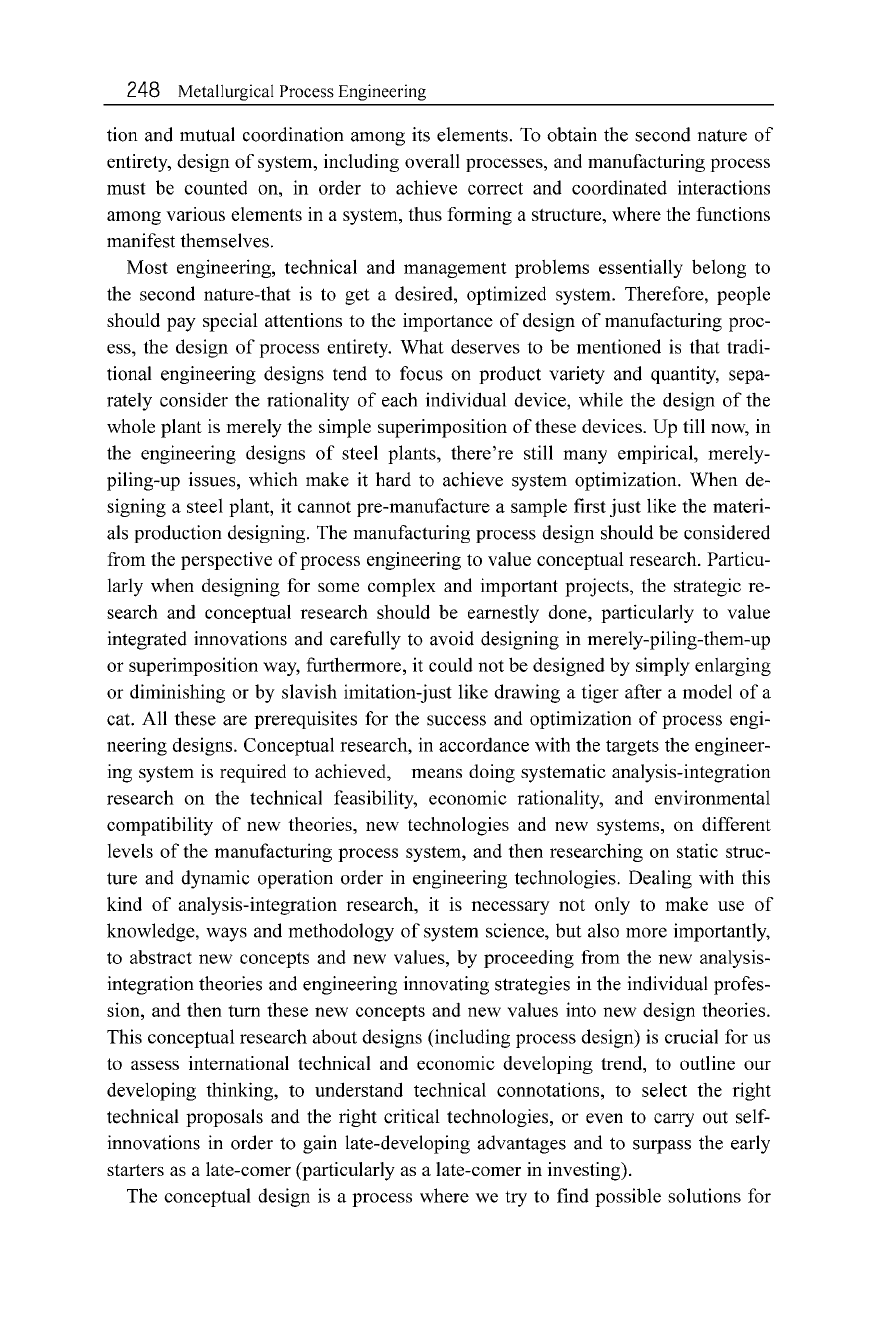
248 Metallurgical Process Engineering
tion and mutual coordination among its elements. To obtain the second nature
of
entirety, design
of
system, including overall processes, and manufacturing process
must be counted on, in order to achieve correct and coordinated interactions
among various elements in a system, thus forming a structure, where the functions
manifest themselves.
Most engineering, technical and management problems essentially belong to
the second nature-that is to get a desired, optimized system. Therefore, people
should pay special attentions to the importance
of
design
of
manufacturing proc-
ess, the design
of
process entirety. What deserves to be mentioned is that tradi-
tional engineering designs tend to focus on product variety and quantity, sepa-
rately consider the rationality
of
each individual device, while the design
of
the
whole plant is merely the simple superimposition
of
these devices. Up till now, in
the engineering designs
of
steel plants, there're still many empirical, merely-
piling-up issues, which make it hard to achieve system optimization. When de-
signing a steel plant, it cannot pre-manufacture a sample first just like the materi-
als production designing. The manufacturing process design should be considered
from the perspective
of
process engineering to value conceptual research. Particu-
larly when designing for some complex and important projects, the strategic re-
search and conceptual research should be earnestly done, particularly to value
integrated innovations and carefully to avoid designing in merely-piling-them-up
or superimposition way, furthermore, it could not be designed by simply enlarging
or diminishing or by slavish imitation-just like drawing a tiger after a model
of
a
cat. All these are prerequisites for the success and optimization
of
process engi-
neering designs. Conceptual research, in accordance with the targets the engineer-
ing system is required to achieved, means doing systematic analysis-integration
research on the technical feasibility, economic rationality, and environmental
compatibility
of
new theories, new technologies and new systems, on different
levels
of
the manufacturing process system, and then researching on static struc-
ture and dynamic operation order in engineering technologies. Dealing with this
kind
of
analysis-integration research, it is necessary not only to make use
of
knowledge, ways and methodology
of
system science, but also more importantly,
to abstract new concepts and new values, by proceeding from the new analysis-
integration theories and engineering innovating strategies in the individual profes-
sion, and then tum these new concepts and new values into new design theories.
This conceptual research about designs (including process design) is crucial for us
to assess international technical and economic developing trend, to outline our
developing thinking, to understand technical connotations, to select the right
technical proposals and the right critical technologies, or even to carry out self-
innovations in order to gain late-developing advantages and to surpass the early
starters as a late-comer (particularly as a late-comer in investing).
The conceptual design is a process where we try to find possible solutions for
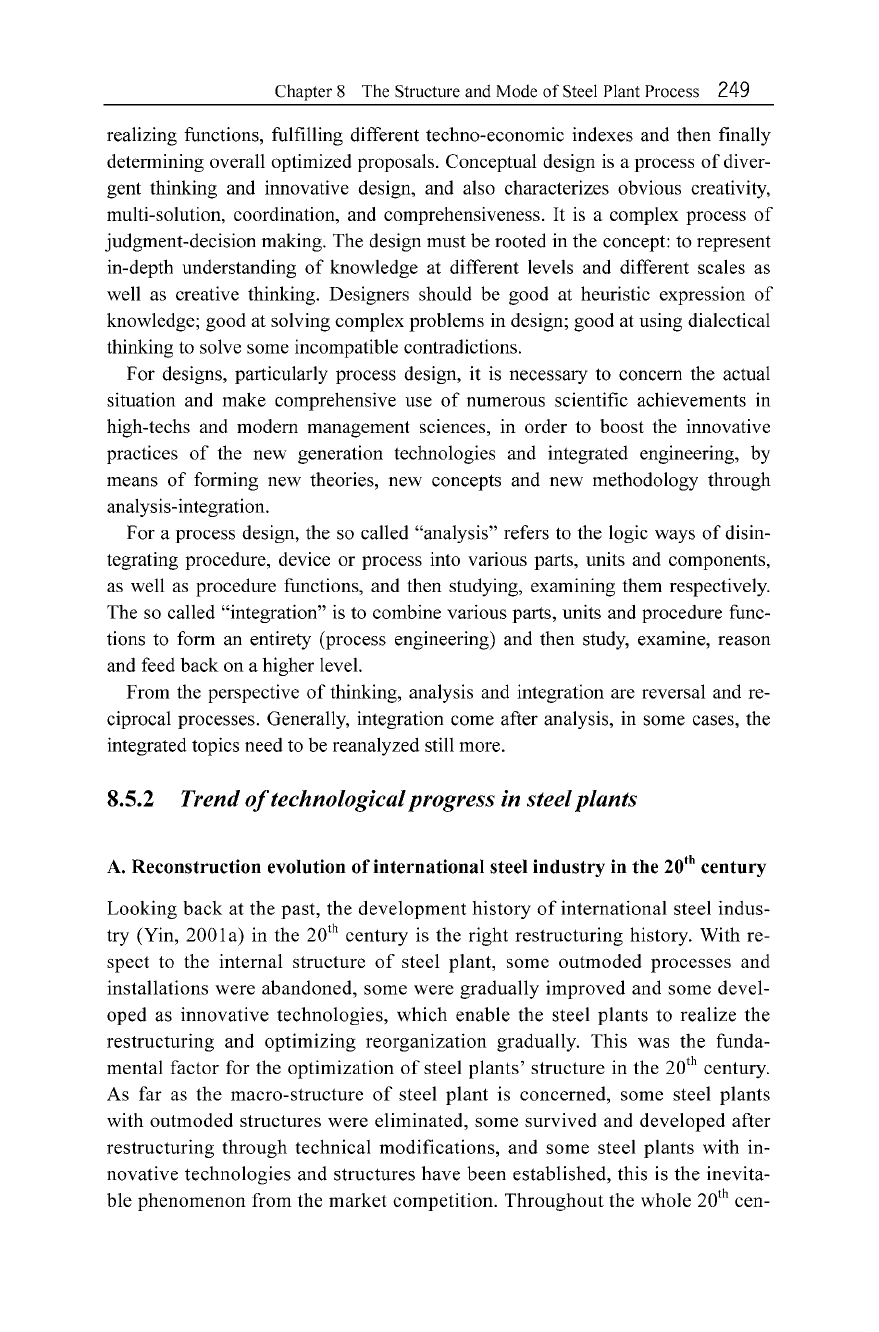
Chapter 8 The Structure and Mode
of
Steel Plant Process 249
realizing functions, fulfilling different techno-economic indexes and then finally
determining overall optimized proposals. Conceptual design is a process
of
diver-
gent thinking and innovative design, and also characterizes obvious creativity,
multi-solution, coordination, and comprehensiveness.
It
is a complex process
of
judgment-decision making. The design must be rooted in the concept: to represent
in-depth understanding
of
knowledge at different levels and different scales as
well as creative thinking. Designers should be good at heuristic expression
of
knowledge; good at solving complex problems in design; good at using dialectical
thinking to solve some incompatible contradictions.
For designs, particularly process design, it is necessary to concern the actual
situation and make comprehensive use
of
numerous scientific achievements in
high-techs and modem management sciences, in order to boost the innovative
practices
of
the new generation technologies and integrated engineering, by
means
of
forming new theories, new concepts and new methodology through
analysis-integration.
For a process design, the so called "analysis" refers to the logic ways
of
disin-
tegrating procedure, device or process into various parts, units and components,
as well as procedure functions, and then studying, examining them respectively.
The so called "integration" is to combine various parts, units and procedure func-
tions to form an entirety (process engineering) and then study, examine, reason
and feed back on a higher level.
From the perspective
of
thinking, analysis and integration are reversal and re-
ciprocal processes. Generally, integration come after analysis, in some cases, the
integrated topics need to be reanalyzed still more.
8.5.2 Trend
of
technological progress in steelplants
A. Reconstruction evolution of international steel
industry
in the 20
th
century
Looking back at the past, the development history
of
international steel indus-
try (Yin, 200 1a) in the 20
th
century is the right restructuring history. With re-
spect to the internal structure
of
steel plant, some outmoded processes and
installations were abandoned, some were gradually improved and some devel-
oped as innovative technologies, which enable the steel plants to realize the
restructuring and optimizing reorganization gradually. This was the funda-
mental factor for the optimization
of
steel plants' structure in the
zo"
century.
As far as the macro-structure
of
steel plant is concerned, some steel plants
with outmoded structures were eliminated, some survived and developed after
restructuring through technical modifications, and some steel plants with in-
novative technologies and structures have been established, this is the inevita-
ble phenomenon from the market competition. Throughout the whole 20
th
cen-
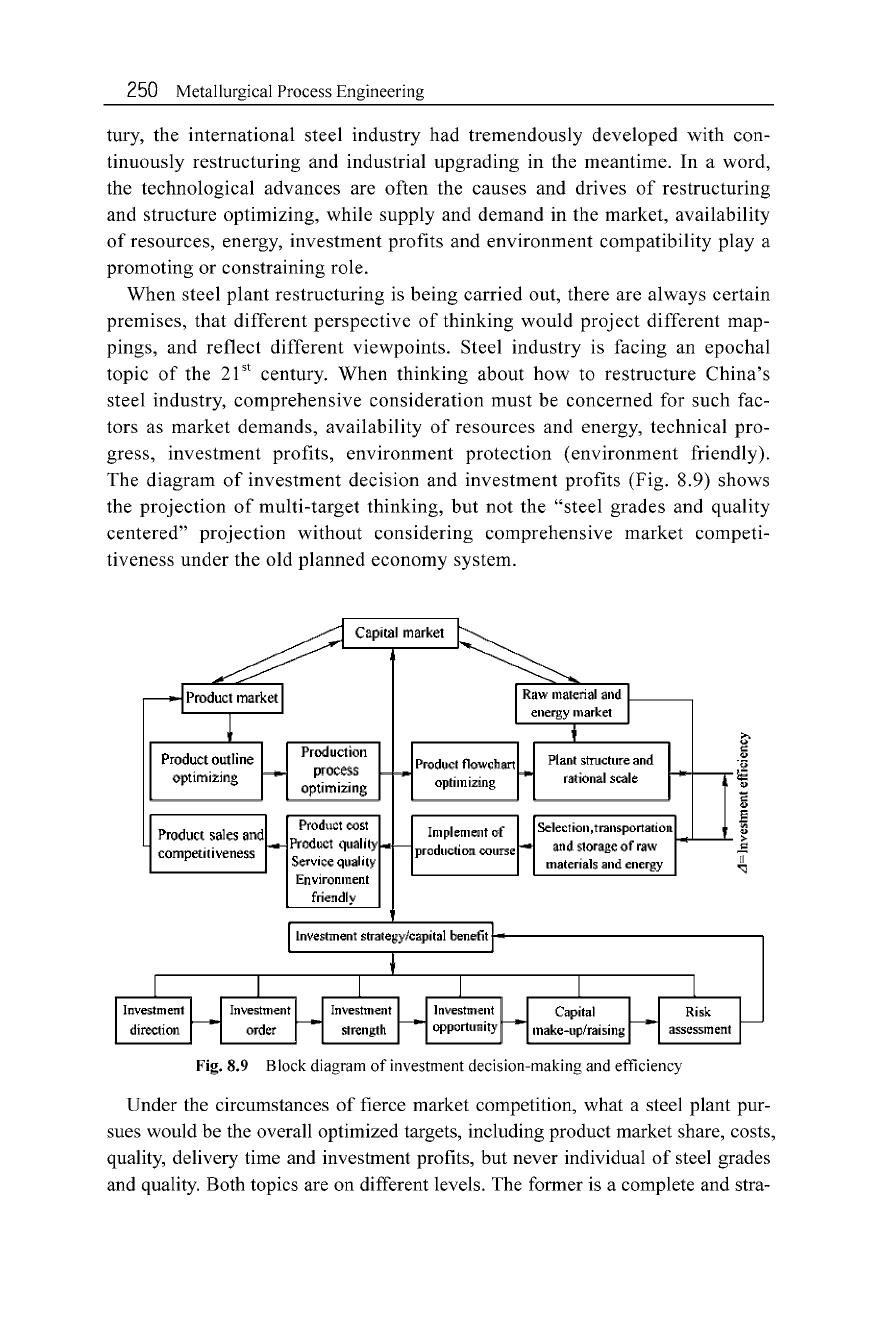
250
Metallurgical Process Engineering
tury, the international steel industry had tremendously developed with con-
tinuously restructuring and industrial upgrading in the meantime. In a word,
the technological advances are often the causes and drives
of
restructuring
and structure optimizing, while supply and demand in the market, availability
of
resources, energy, investment profits and environment compatibility
playa
promoting or constraining role.
When steel plant restructuring is being carried out, there are always certain
premises, that different perspective
of
thinking would project different map-
pings, and reflect different viewpoints. Steel industry is facing an epochal
topic
of
the 21st century. When thinking about how to restructure China's
steel industry, comprehensive consideration must be concerned for such fac-
tors as market demands, availability
of
resources and energy, technical pro-
gress, investment profits, environment protection (environment friendly).
The diagram
of
investment decision and investment profits (Fig. 8.9) shows
the projection
of
multi-target thinking, but not the "steel grades and quality
centered" projection without considering comprehensive market competi-
tiveness under the old planned economy system.
Fig.8.9 Block diagram of investment decision-making and efficiency
Under the circumstances
of
fierce market competition, what a steel plant pur-
sues would be the overall optimized targets, including product market share, costs,
quality, delivery time and investment profits, but never individual
of
steel grades
and quality. Both topics are on different levels. The former is a complete and stra-
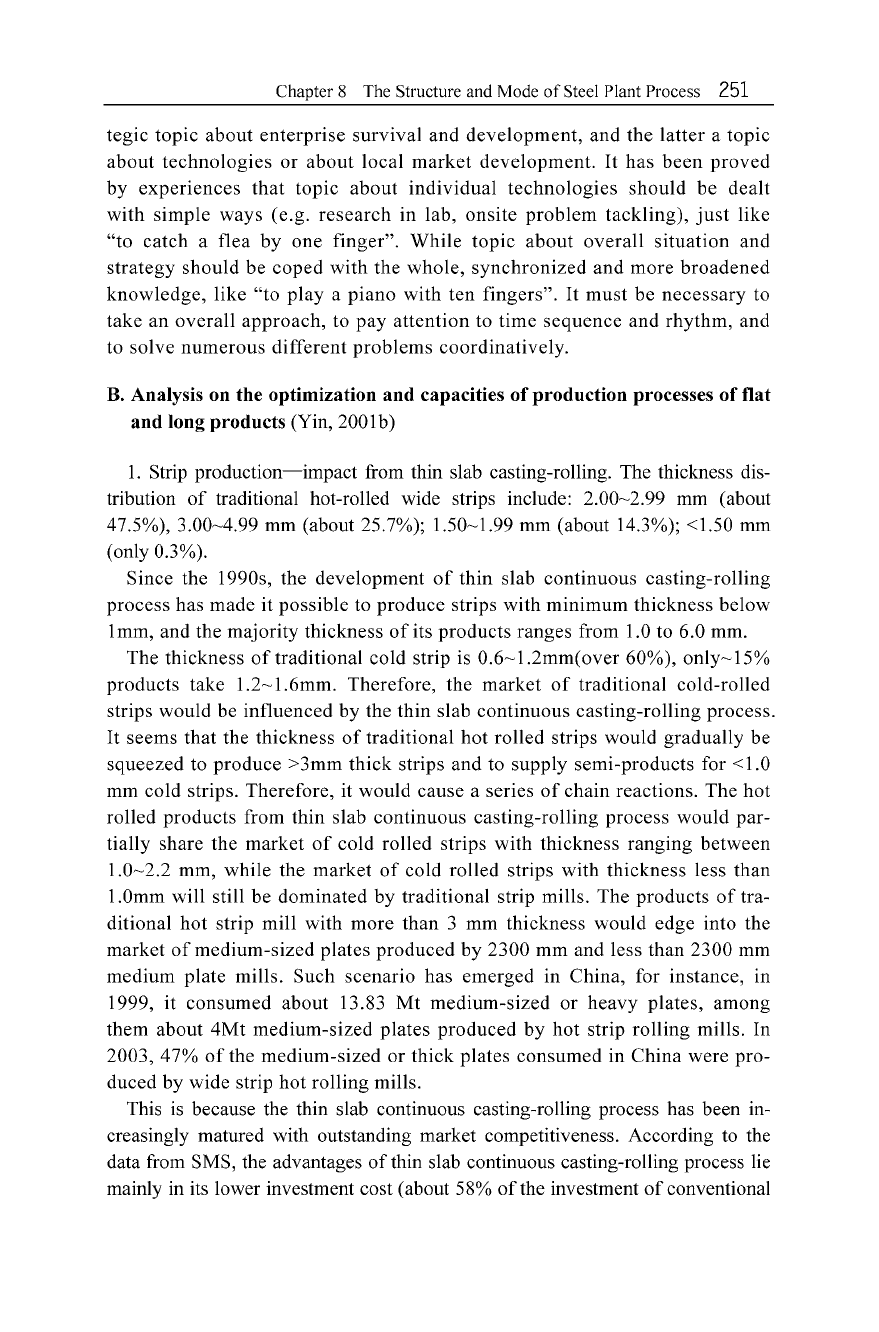
Chapter 8 The Structure and Mode
of
Steel Plant Process
251
tegic topic about enterprise survival and development, and the latter a topic
about technologies or about local market development.
It
has
been
proved
by experiences that topic about individual technologies should be dealt
with simple ways (e.g. research in lab, onsite problem tackling),
just
like
"to
catch a flea by one finger". While topic about overalI situation and
strategy should be coped with the whole, synchronized and more broadened
knowledge, like
"to
playa
piano with ten fingers".
It
must be necessary to
take an overall approach, to pay attention to time sequence and rhythm, and
to solve numerous different problems coordinatively.
B. Analysis on the optimization
and
capacities of
production
processes of flat
and
long
products
(Yin, 2001b)
1. Strip production
-impact
from thin slab casting-rolling. The thickness dis-
tribution
of
traditional hot-rolled wide strips include:
2
.00
~2
.99
mm (about
47.5%),
3.00
~4
.99
mm (about 25.7%);
1.50
~1.99
mm (about 14.3%); <1.50 mm
(only 0.3%).
Since the 1990s, the development
of
thin slab continuous casting-rolling
process has made it possible to produce strips with minimum thickness below
1mm, and the majority thickness
of
its products ranges from 1.0 to 6.0 mm.
The thickness
of
traditional cold strip is
0
.6
~
1.2mm(over 60%), only-:15%
products take
1
.2
~
1.6mm. Therefore, the market
of
traditional cold-rolled
strips would be influenced by the thin slab continuous casting-rolling process.
It
seems that the thickness
of
traditional hot rolIed strips would gradualIy be
squeezed to produce >3mm thick strips and to supply semi-products for <1.0
mm cold strips. Therefore, it would cause a series
of
chain reactions. The hot
rolled products from thin slab continuous casting-rolling process would par-
tially share the market
of
cold rolled strips with thickness ranging between
1
.0
~2.2
mm, while the market
of
cold rolIed strips with thickness less than
1.0mm wilI stilI be dominated by traditional strip milIs. The products
of
tra-
ditional hot strip mill with more than 3 mm thickness would edge into the
market
of
medium-sized plates produced by 2300 mm and less than 2300 mm
medium plate mills . Such scenario has emerged in China, for instance, in
1999, it consumed about 13.83 Mt medium-sized or heavy plates, among
them about 4Mt medium-sized plates produced by hot strip rolling mills. In
2003, 47%
of
the medium-sized or thick plates consumed in China were pro-
duced by wide strip hot rolIing milIs.
This is because the thin slab continuous casting-rolling process has been in-
creasingly matured with outstanding market competitiveness. According to the
data from SMS, the advantages
of
thin slab continuous casting-rolIing process lie
mainly in its lower investment cost (about 58%
of
the investment
of
conventional
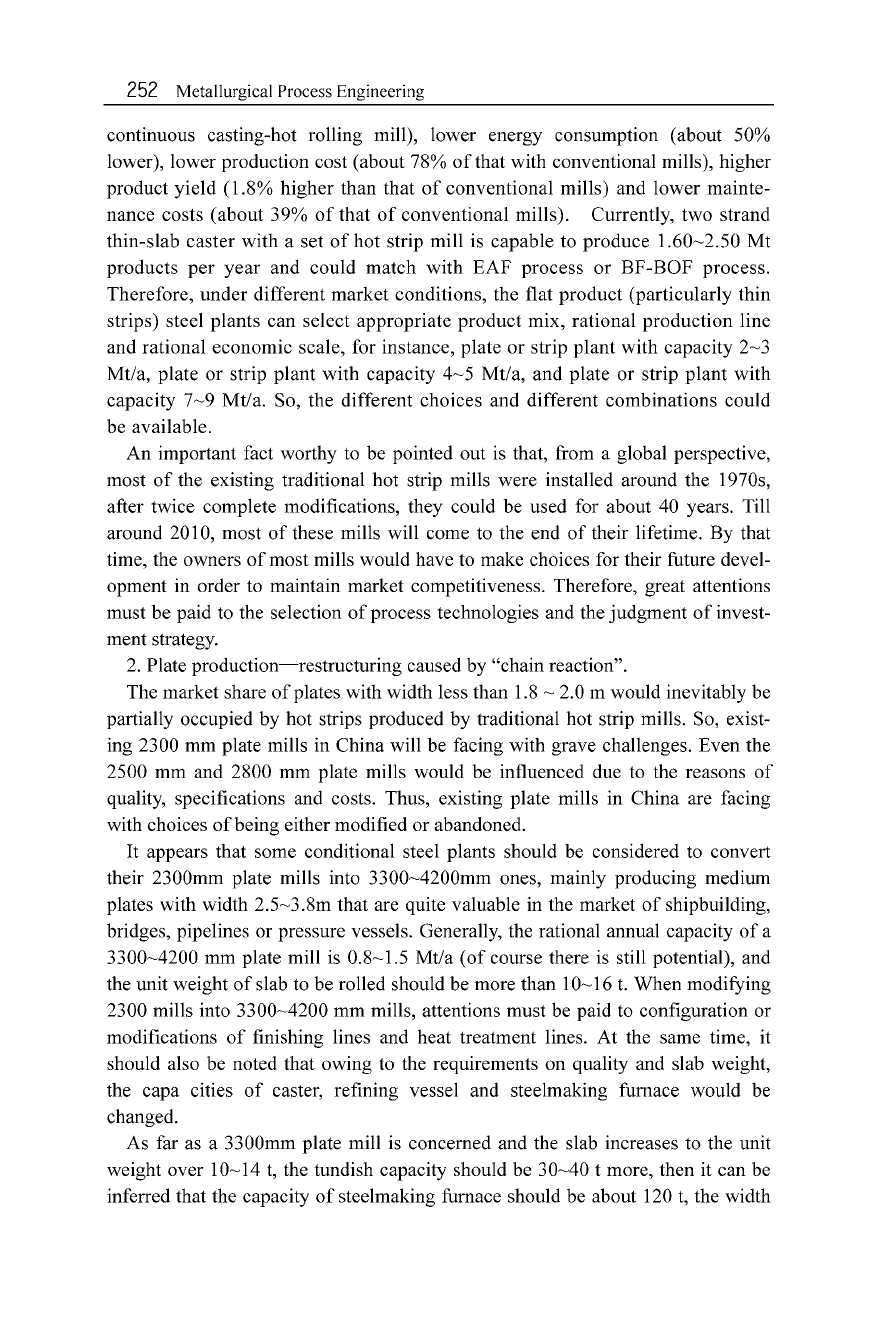
252
Metallurgical Process Engineering
continuous casting-hot rolIing milI), lower energy consumption (about 50%
lower), lower production cost (about 78%
of
that with conventional mills), higher
product yield (1.8% higher than that
of
conventional mills) and lower mainte-
nance costs (about 39%
of
that
of
conventional mills). Currently, two strand
thin-slab caster with a set
of
hot strip mill is capable to produce
1.60
~2.50
Mt
products per year and could match with EAF process or BF-BOF process.
Therefore, under different market conditions, the flat product (particularly thin
strips) steel plants can select appropriate product mix, rational production line
and rational economic scale, for instance, plate or strip plant with capacity
2
~3
Mt/a, plate or strip plant with capacity
4
~5
Mt/a, and plate or strip plant with
capacity
7
~9
Mt/a. So, the different choices and different combinations could
be available.
An important fact worthy to be pointed out is that, from a global perspective,
most
of
the existing traditional hot strip milIs were instalIed around the 1970s,
after twice complete modifications, they could be used for about 40 years. TilI
around 2010, most
of
these milIs wilI come to the end
of
their lifetime. By that
time, the owners
of
most mills would have to make choices for their future devel-
opment in order to maintain market competitiveness. Therefore, great attentions
must be paid to the selection
of
process technologies and the judgment
of
invest-
ment strategy.
2. Plate production-restructuring caused by "chain reaction".
The market share
of
plates with width less than 1.8
~
2.0 m would inevitably be
partialIy occupied by hot strips produced by traditional hot strip milIs. So, exist-
ing 2300 mm plate milIs in China wilI be facing with grave chalIenges. Even the
2500 mm and 2800 mm plate mills would be influenced due to the reasons
of
quality, specifications and costs. Thus, existing plate mills in China are facing
with choices
of
being either modified or abandoned.
It
appears that some conditional steel plants should be considered to convert
their 2300mm plate milIs into
3300
~4200mm
ones, mainly producing medium
plates with width
2.5
~3.8m
that are quite valuable in the market
of
shipbuilding,
bridges, pipelines or pressure vessels. Generally, the rational annual capacity
of
a
3300
~4200
mm plate milI is 0.8
-1.5
Mt/a
(of
course there is stilI potential), and
the unit weight
of
slab to be rolIed should be more than 1
O
~
16 1. When modifying
2300 mills into 3300
-4200
mm mills, attentions must be paid to configuration or
modifications
of
finishing lines and heat treatment lines. At the same time, it
should also be noted that owing to the requirements on quality and slab weight,
the capa cities
of
caster, refining vessel and steelmaking furnace would be
changed.
As far as a 3300mm plate milI is concerned and the slab increases to the unit
weight over 10
-14
t, the tundish capacity should be 30
-40
t more, then it can be
inferred that the capacity
of
steelmaking furnace should be about 120 t, the width
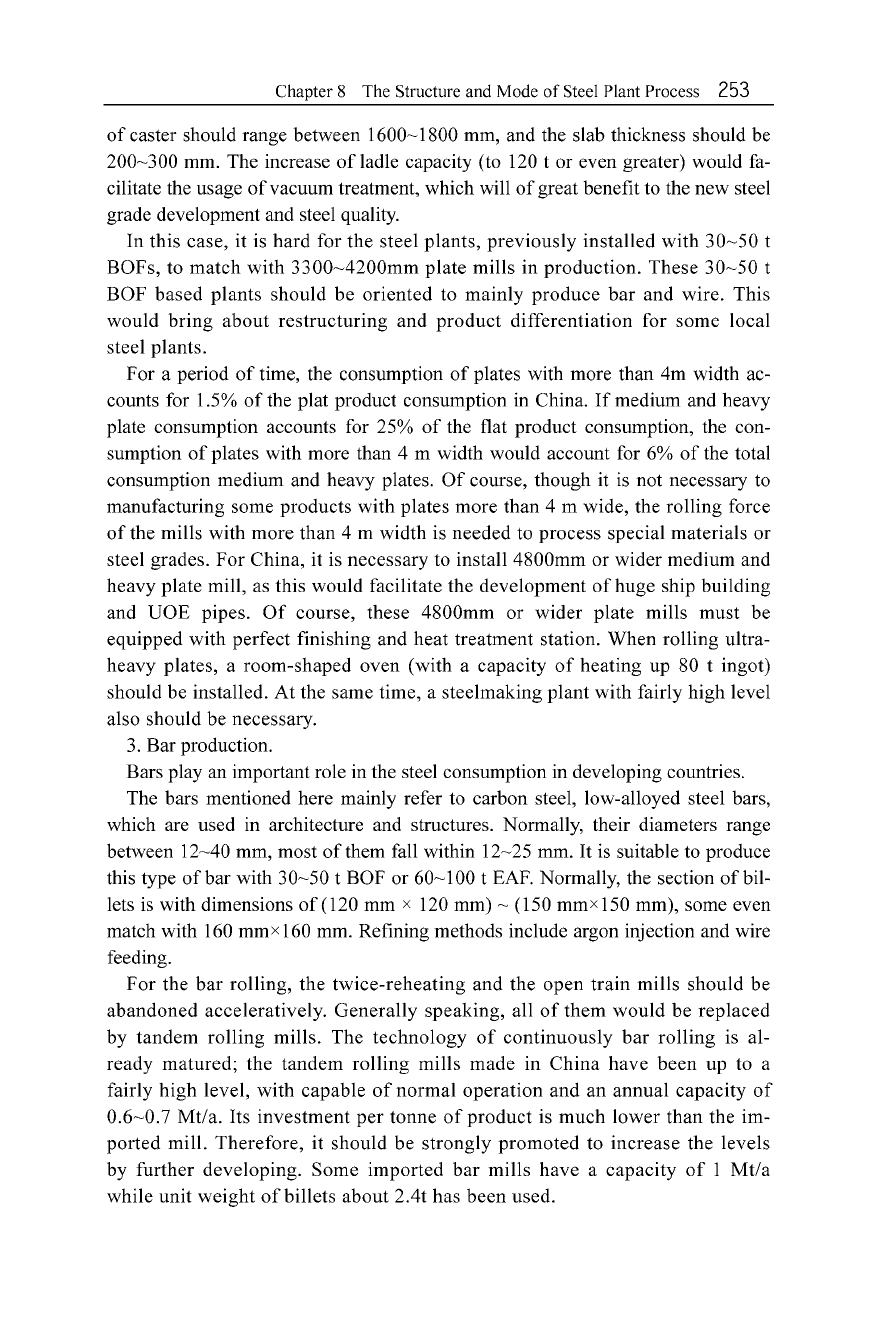
Chapter 8 The Structure and Mode
of
Steel Plant Process
253
of
caster should range between 1600
-1800
mm, and the slab thickness should be
200
-300
mm. The increase
of
ladle capacity (to 120 t or even greater) would fa-
cilitate the usage
of
vacuum treatment, which will
of
great benefit to the new steel
grade development and steel quality.
In this case, it is hard for the steel plants, previously installed with 30
-50
t
BOFs, to match with 3300
-4200mm
plate mills in production. These 30
-50
t
BOF based plants should be oriented to mainly produce bar and wire. This
would bring about restructuring and product differentiation for some local
steel plants.
For a period
of
time, the consumption
of
plates with more than 4m width ac-
counts for 1.5%
of
the plat product consumption in China. If medium and heavy
plate consumption accounts for 25%
of
the flat product consumption, the con-
sumption
of
plates with more than 4 m width would account for 6%
of
the total
consumption medium and heavy plates.
Of
course, though it is not necessary to
manufacturing some products with plates more than 4 m wide, the rolling force
of
the mills with more than 4 m width is needed to process special materials or
steel grades . For China, it is necessary to install 4800mm or wider medium and
heavy plate mill, as this would facilitate the development
of
huge ship building
and UOE pipes.
Of
course, these 4800mm or wider plate mills must be
equipped with perfect finishing and heat treatment station. When rolling ultra-
heavy plates, a room-shaped oven (with a capacity
of
heating up 80 t ingot)
should be installed. At the same time, a steelmaking plant with fairly high level
also should be necessary.
3. Bar production.
Bars play an important role in the steel consumption in developing countries.
The bars mentioned here mainly refer to carbon steel, low-alloyed steel bars,
which are used in architecture and structures. Normally, their diameters range
between 12
-40
mm, most
of
them fall within 12
-25
mm. It is suitable to produce
this type
of
bar with 30
-50
t BOF or 60
-100
t EAF. Normally, the section
of
bil-
lets is with dimensions
of
(120 mm x 120 mm) - (150 rnmxlSn mm), some even
match with 160 mmx160 mm. Refining methods include argon injection and wire
feeding.
For the bar rolling, the twice-reheating and the open train mills should be
abandoned acceleratively. Generally speaking, all
of
them would be replaced
by tandem rolling mills. The technology
of
continuously bar rolling is al-
ready matured; the tandem rolling mills made in China have been up to a
fairly high level, with capable
of
normal operation and an annual capacity
of
0.6
-0.7
Mt/a. Its investment per tonne
of
product is much lower than the im-
ported mill. Therefore, it should be strongly promoted to increase the levels
by further developing. Some imported bar mills have a capacity
of
1 Mt/a
while unit weight
of
billets about 2.4t has been used.
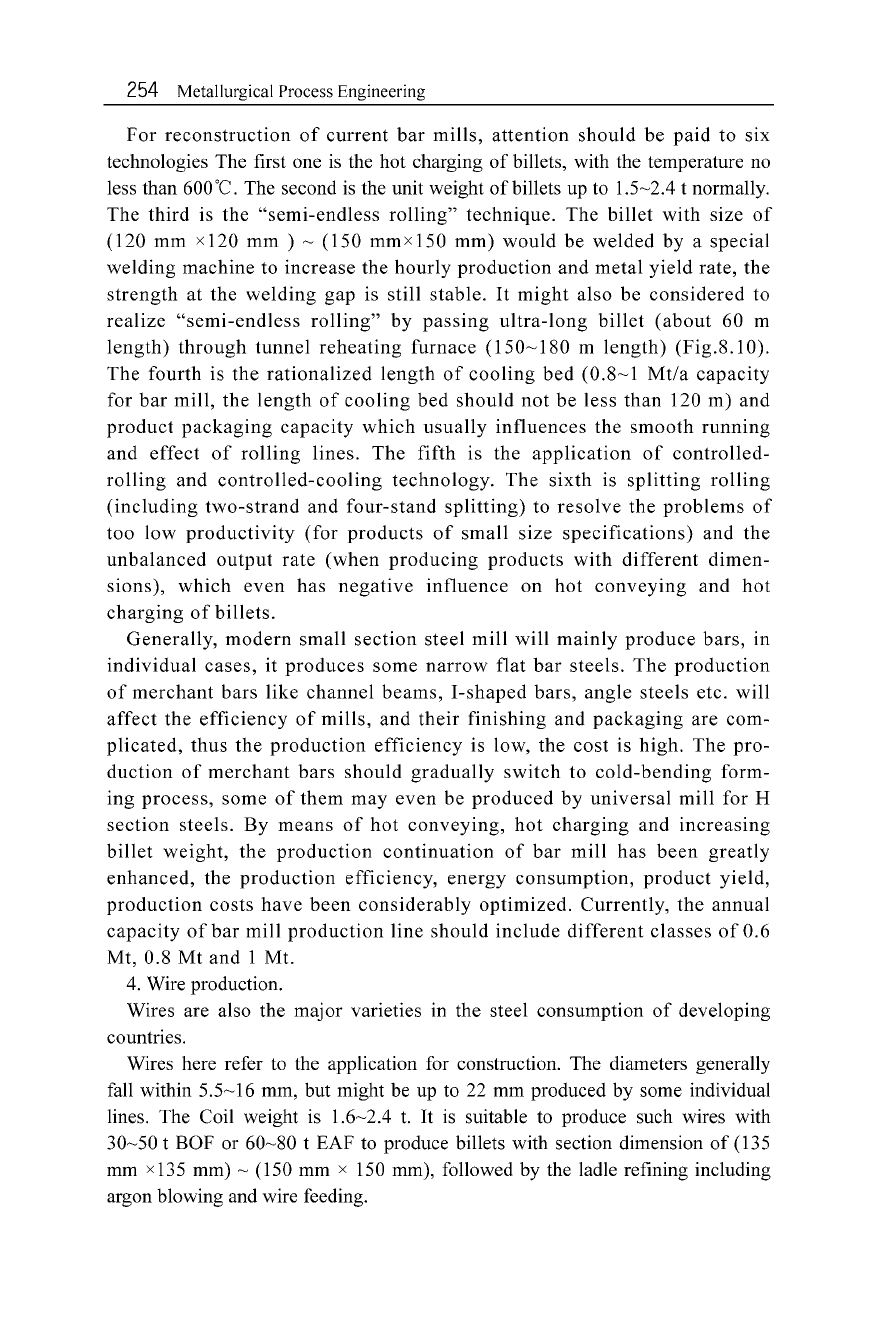
254
Metallurgical Process Engineering
For reconstruction
of
current
bar
miIls, attention should be paid to six
technologies The first one is the hot charging
of
billets, with the temperature no
less than 600'C. The second is the unit weight
of
billets up to
1.5
~2.4
t normally.
The third is the "semi-endless rolling" technique. The billet with size
of
(120 mm x120 mm )
~
(150 mrn x l Sn mm) would be welded by a special
welding machine to increase the hourly production and metal yield rate, the
strength
at the
welding
gap is still stable.
It
might
also be
considered
to
realize
"semi-endless
rolling"
by
passing
ultra-long
billet
(about
60 m
length)
through
tunnel
reheating
furnace
(150
~
180 m length) (Fig.8.10).
The fourth is the
rationalized
length
of
cooling
bed (0.8
-1
Mtla
capacity
for
bar
miIl, the length
of
cooling
bed should
not
be less than 120 m) and
product
packaging
capacity
which
usually
influences the
smooth
running
and effect
of
rolling
lines. The fifth is the
application
of
controlled-
roIling and
controIled-cooling
technology. The sixth is
splitting
roIling
(including
two-strand
and four-stand
splitting)
to resolve the
problems
of
too low
productivity
(for
products
of
smaIl size
specifications)
and the
unbalanced
output
rate
(when
producing
products
with
different
dimen-
sions),
which
even
has
negative
influence
on hot
conveying
and
hot
charging
of
biIlets.
GeneraIly, modern smaIl
section
steel miIl wiIl mainly
produce
bars, in
individual cases, it
produces
some
narrow
flat
bar
steels.
The
production
of
merchant
bars like
channel
beams, I-shaped bars, angle steels etc . will
affect the
efficiency
of
miIls, and
their
finishing and
packaging
are com-
plicated,
thus the
production
efficiency
is low, the cost is high.
The
pro-
duction
of
merchant
bars
should
gradually
switch
to
cold-bending
form-
ing process, some
of
them may
even
be
produced
by
universal
mill for H
section
steels. By means
of
hot
conveying,
hot
charging
and
increasing
biIlet weight, the
production
continuation
of
bar
miIl has been
greatly
enhanced,
the
production
efficiency,
energy
consumption,
product
yield,
production
costs
have
been
considerably
optimized
. Currently, the annual
capacity
of
bar
mill
production
line should include
different
classes
of
0.6
Mt, 0.8 Mt
and
1 Mt.
4. Wire production.
Wires are also the major varieties in the steel consumption
of
developing
countries.
Wires here refer to the application for construction. The diameters generaIly
fall within
5
.5
~16
mm, but might be up to 22 mm produced by some individual
lines. The Coil weight is
1
.6
~2.4
1. It is suitable to produce such wires with
30
-50
t BOF or 60
-80
t EAF to produce billets with section dimension
of
(135
mm x135 mm)
~
(150 mm x 150 mm), followed by the ladle refining including
argon blowing and wire feeding.
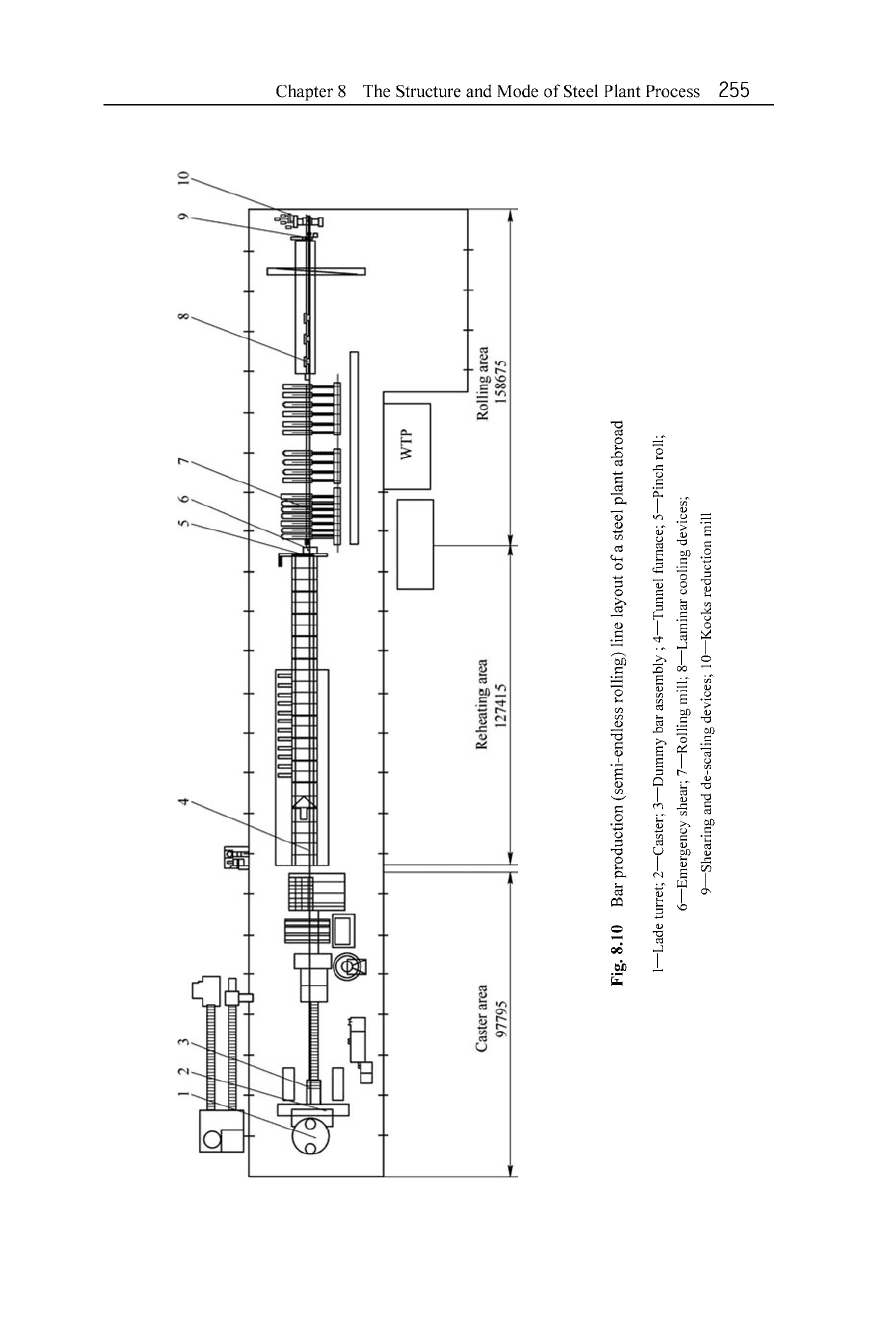
2 3 -I 5 6 7 8
9
10
Reheating area
127-115
Caster
area
97795
Fig. 8.10 Barproduction (semi-endless rolling) line layout
of
a steel plant abroad
I- Lade turret; 2
-Cas
ter; 3
-Dumm
y bar assembly ; 4- Tunnel furnace; 5- Pinch roll;
6- Emergency shear; 7- Rolling mill; 8
-L
aminar cooling devices;
9- Shearing and de-scaling devices; IO
-K
ocks reduction mill
Rolling
area
158675
o
:;-
0:>
"S
(l)
....
00
-J
:;-
(l)
:!'
2
()
C
<i1
0:>
::l
0-
$:
o
0-
(l)
o
....,
:!'
(l)
~
"'0
;;-
a
"'0
d
()
(l)
V>
V>
N
<.Jl
<.Jl
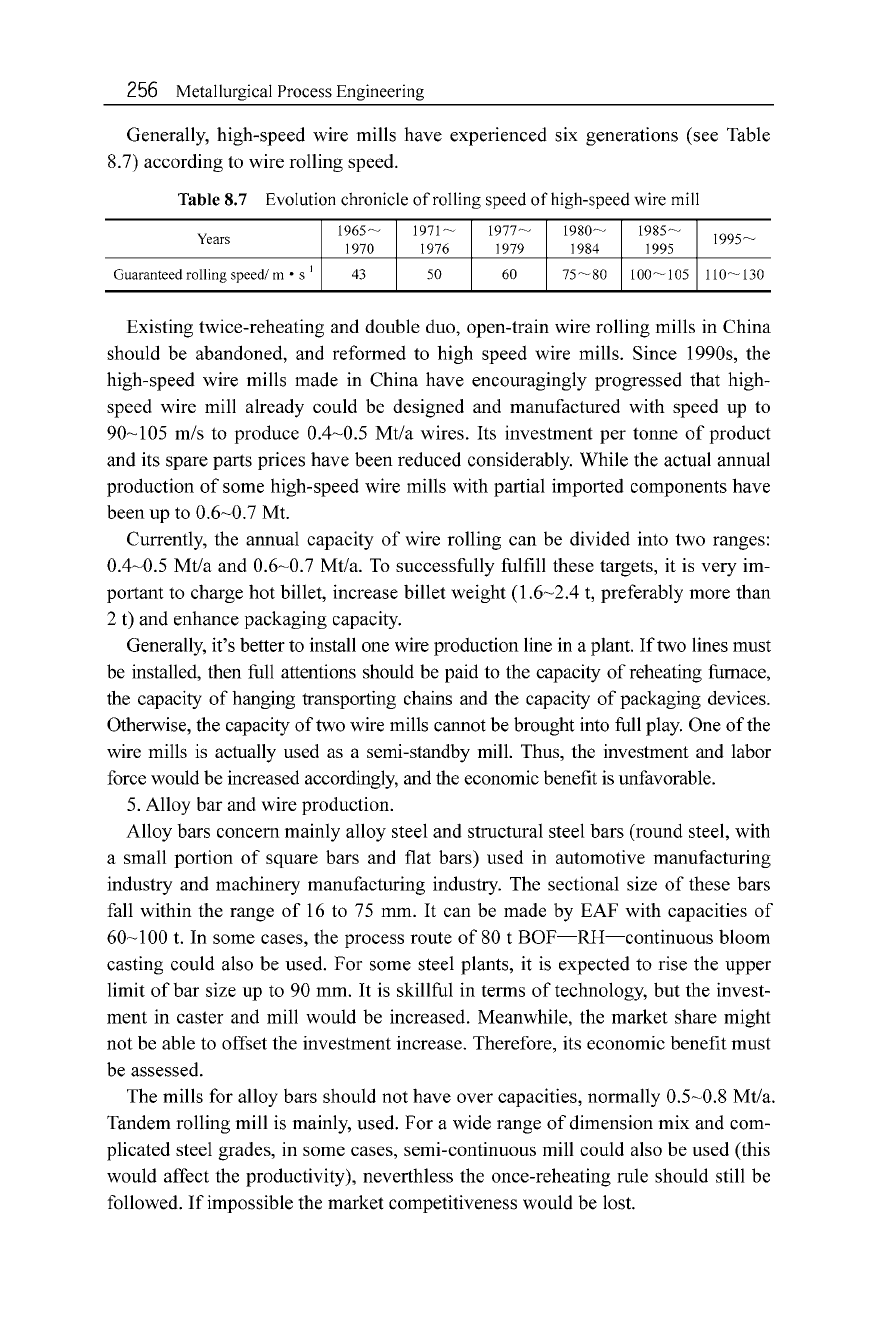
256
Metallurgical
Proce
ss Engineering
Generally, high-speed wire mills have experienced six generations (see Table
8.7) according to wire rolling speed.
Table 8.7 Evolution
chronicle
of
rolling
speed of
high-speed
wire
mill
Years
196
5
~
19 71
~
1977
~
1980
~
198
5
~
1995
~
1970 1976 1979 1984 1995
Guaranteed rolling speed! m • s-l
43 50 60
75
~80
100
~1O
5
llO
~130
Existing twice-reheating and double duo, open-train wire rolling mills in China
should be abandoned, and reformed to high speed wire mills. Since 1990s, the
high-speed wire mills made in China have encouragingly progressed that high-
speed wire mill already could be designed and manufactured with speed up to
90
~
I05 m/s to produce
0.4
~0
.5
Mt/a wires. Its investment per tonne
of
product
and its spare parts prices have been reduced considerably. While the actual annual
production
of
some high-speed wire mills with partial imported components have
been up to 0.6
-0.7
Mt.
Currently, the annual capacity
of
wire rolling can be divided into two ranges:
0.4
~0
.5
Mt/a and
0
.6
~0
.7
Mt/a. To successfully fulfill these targets, it is very im-
portant to charge hot billet, increase billet weight (1.6
-2.4
t, preferably more than
2 t) and enhance packaging capacity.
Generally, it's better to install one wire production line in a plant. If two lines must
be installed, then full attentions should be paid to the capacity of reheating furnace,
the capacity
of
hanging transporting chains and the capacity
of
packaging devices.
Otherwise, the capacity
of
two wire mills cannot be brought into full play.One
of
the
wire mills is actually used as a semi-standby mill. Thus, the investment and labor
force would be increased accordingly,and the economic benefit is unfavorable.
5. Alloy bar and wire production.
Alloy bars concern mainly alloy steel and structural steel bars (round steel, with
a small portion
of
square bars and flat bars) used in automotive manufacturing
industry and machinery manufacturing industry. The sectional size
of
these bars
fall within the range
of
16 to 75 mm. It can be made by EAF with capacities
of
60
-100
t. In some cases, the process route
of
80 t
BOF-RH-continuous
bloom
casting could also be used. For some steel plants, it is expected to rise the upper
limit
of
bar size up to 90 mm. It is skillful in terms
of
technology, but the invest-
ment in caster and mill would be increased. Meanwhile, the market share might
not be able to offset the investment increase. Therefore, its economic benefit must
be assessed.
The mills for alloy bars should not have over capacities, normally
0.5
~0
.8
Mt/a.
Tandem rolling mill is mainly, used. For a wide range
of
dimension mix and com-
plicated steel grades, in some cases, semi-continuous mill could also be used (this
would affect the productivity), neverthless the once-reheating rule should still be
followed. Ifimpossible the market competitiveness would be lost.
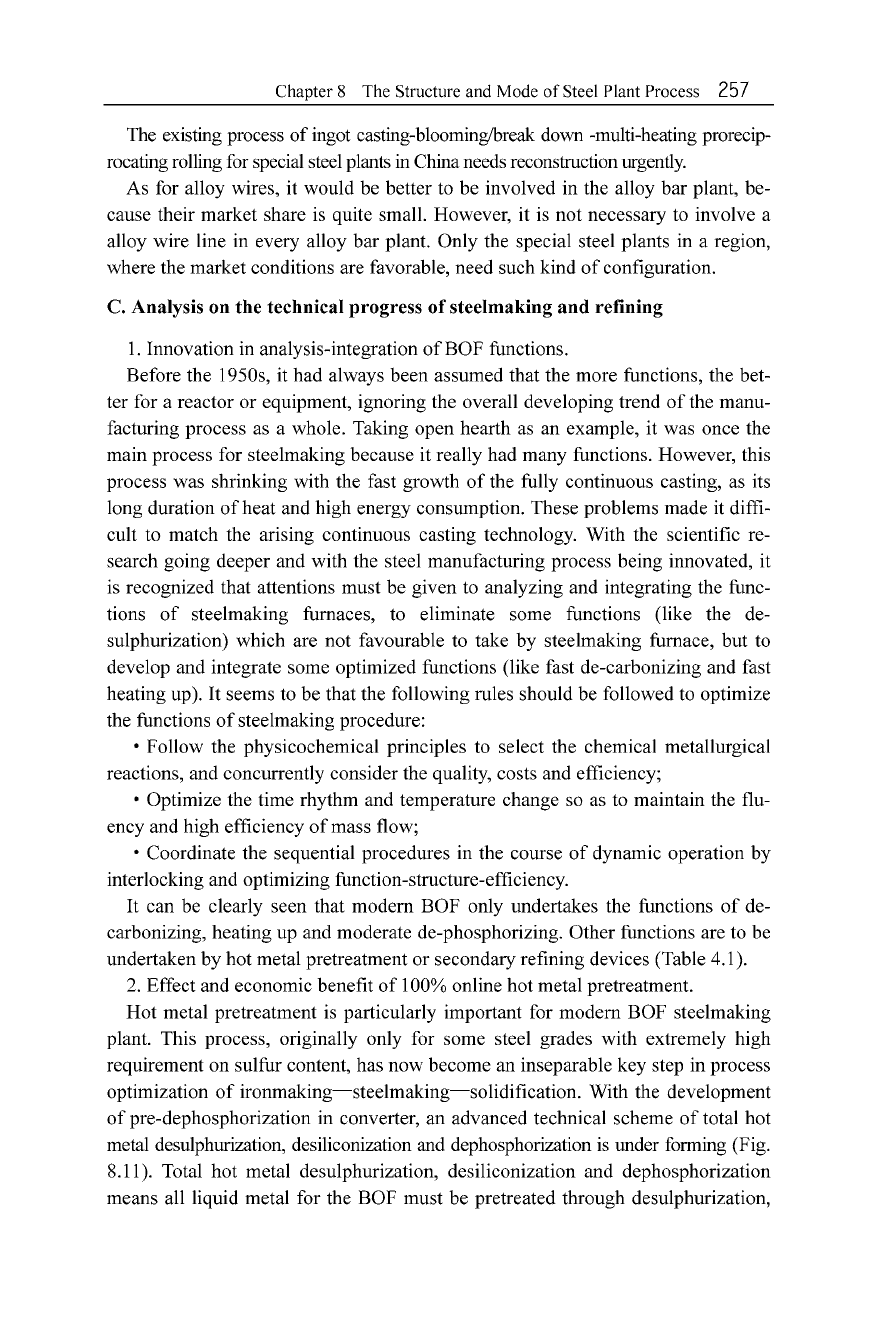
Chapter 8 The Structure and Mode
of
Steel Plant Process
257
The existingprocess of ingot casting-bloominglbreak down -multi-heating prorecip-
rocatingrollingfor specialsteelplantsinChinaneedsreconstruction urgently.
As for alloy wires, it would be better to be involved in the alloy bar plant, be-
cause their market share is quite small. However, it is not necessary to involve a
alloy wire line in every alloy bar plant. Only the special steel plants in a region,
where the market conditions are favorable, need such kind
of
configuration.
C. Analysis on the technical progress of steelmaking
and
refining
I. Innovation in analysis-integration
of
BOF functions.
Before the 1950s, it had always been assumed that the more functions, the bet-
ter for a reactor or equipment, ignoring the overall developing trend
of
the manu-
facturing process as a whole. Taking open hearth as an example, it was once the
main process for steelmaking because it really had many functions. However, this
process was shrinking with the fast growth
of
the fully continuous casting, as its
long duration
of
heat and high energy consumption. These problems made it diffi-
cult to match the arising continuous casting technology. With the scientific re-
search going deeper and with the steel manufacturing process being innovated, it
is recognized that attentions must be given to analyzing and integrating the func-
tions
of
steelmaking furnaces, to eliminate some functions (like the de-
sulphurization) which are not favourable to take by steelmaking furnace, but to
develop and integrate some optimized functions (like fast de-carbonizing and fast
heating up).
It seems to be that the following rules should be followed to optimize
the functions
of
steelmaking procedure :
• Follow the physicochemical principles to select the chemical metallurgical
reactions, and concurrently consider the quality, costs and efficiency;
• Optimize the time rhythm and temperature change so as to maintain the flu-
ency and high efficiency
of
mass flow;
• Coordinate the sequential procedures in the course
of
dynamic operation by
interlocking and optimizing function-structure-efficiency.
It
can be clearly seen that modem BOF only undertakes the functions
of
de-
carbonizing, heating up and moderate de-phosphorizing. Other functions are to be
undertaken by hot metal pretreatment or secondary refining devices (Table 4.1).
2. Effect and economic benefit
of
100% online hot metal pretreatment.
Hot metal pretreatment is particularly important for modem BOF steelmaking
plant. This process, originally only for some steel grades with extremely high
requirement on sulfur content, has now become an inseparable key step in process
optimization
of
ironmaking
-steelmakin
g-
solidification. With the development
of
pre-dephosphorization in converter, an advanced technical scheme
of
total hot
metal desulphurization, desiliconization and dephosphorization is under forming (Fig.
8.11). Total hot metal desulphurization, desiliconization and dephosphorization
means all liquid metal for the BOF must be pretreated through desulphurization,
